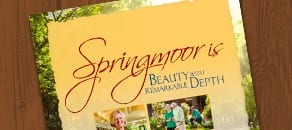
After being on our waitlist for more than two years, Barbara Parker and her husband George became members of the Springmoor community in January of 2020. They used a variety of strategies to gradually pare down their belongings before their move and were happy to share their experiences in the hope of helping others.
“The most challenging aspect of making the transition to retirement living was downsizing,” says Barbara. “We had lived in the same house in the North Hills area of Raleigh for 52 years and had accumulated a fair amount of stuff. It takes time to figure out what not to bring with you and what to do with it.”
The Parkers’ house sold in less than a week; fortunately, they had begun downsizing far in advance. Barbara recommends that you start the process by calculating how many square feet of space you will have once you move to a retirement community and what percentage of your current stuff will fit.
Living Large in a Smaller Space
“We knew our space—thus our possessions—would be reduced in half after we moved,” says Barbara, “so I made a list of the furniture, tables, lamps, and rugs in each room of our house. My husband and I went through each room and checked off which items we each wanted to take. To my surprise, we agreed on almost everything, and this aspect was easier than we anticipated.”
The voluminous other stuff in the house was much trickier, however, and the couple benefited from a variety of tactics. One was choosing a specific timeframe (for the Parkers it was Lent) and selecting just one item per day to set aside to be donated. “George and I agreed that we felt much ‘freer’ after this experience,” Barbara says.
Another method for decluttering in advance of your move that Barbara mentions is focusing on a small area such as the coat closet. Set a timer for the amount of time that feels right to you and sort the items in this limited space into categories like trash, recycle, donate, and keep.
Less Is More
For clothes, Barbara suggests hanging all items with the hangers facing backward. As you use them, return them to your closet with the hangers facing forward. After a pre-determined time period, pass on all the clothes with hangers still facing backward to a charity.
When evaluating the contents of your closet, it’s also helpful to give some thought to how you prefer to dress at your current stage of life. Barbara says, “After I retired, I didn’t need all the ‘business casual’ outfits in my closet.” She recommends keeping only a few things that you don’t wear regularly, such as clothes for special occasions like weddings and an item or two with sentimental value.
Many of us have collected shelves of books over the years. Books are heavy to transport, require significant space to store, and are generally readily available in the library if you want to re-read them. Barbara found, however, that George could identify very few he wanted to cull when asked.
A strategy that worked well for this couple was for Barbara to gather all the books she thought they could let go of and stack them on the dining table. “Usually about 100 books were on the table,” she says, “and George would only feel the need to ‘rescue’ about half a dozen.” They donated the rest to the Wake County Public Library for their next library sale. She points out that this technique could be useful for other categories of things as well.
Old magazines are another item that many of us have stockpiled but are unlikely to use again. If you have “treasured volumes” on specific topics like knitting or woodworking that might be of interest to members of an organization, reach out to them. Barbara says, “My retired physicist husband felt good about passing along his professional journals to physics grad students. Otherwise, paper can be recycled. Do it!”
Strategies for Cherished Items
Family photos are tough to winnow because most of us can’t bear to throw any of them out. One suggestion from Barbara is to store favorite photos (separated by acid-free paper and removed from their frames) in a folder, where they require very little room. Another is to display a few at a time in frames, rotating them over a set period of time, so you can enjoy them all in a limited space.
Another category of items that can be tricky to relinquish is holiday decorations. In advance of their move to Springmoor, the Parkers passed along some Christmas ornaments and other holiday items to their adult kids; items they didn’t want were donated to charity. Barbara’s daughter-in-law requested some ornaments with special meaning for their toddler, so that he can enjoy the stories behind them as he grows up.
Are you still keeping the childhood mementos of your adult children? Especially if they have a house of their own, invite them to visit and take the things that hold meaning for them. You could even video the reaction as they encounter their old stuff!
The Parkers found their adult kids didn’t want the majority of the belongings they were getting rid of before moving. “Generally I think most adult kids have their own stuff and a different lifestyle than their parents,” says Barbara. “Out of the things we didn’t bring to Springmoor, our kids only took about a quarter of them.”
So what do you do with family heirlooms, if your kids and grandkids can’t use them? After deciding which few favorite things you MUST keep, it’s time to let the rest go. Barbara found that by sending photos of certain items to an antique store she was able to sell them. A few found new homes with friends.
“Giving up cherished items you no longer need is a lot easier if you know they are going where they will be appreciated,” says Barbara. She explains that, before their move, her husband had four sets of golf clubs with some sentimental value. One set was from his dad and another was custom-made.
After some deliberation, George kept only the custom-made set and donated the others to First Tee. This nonprofit provides clubs to kids who can’t afford them.
Our friendly team would welcome the opportunity to walk you through how your downsizing and move-in process could unfold. Contact us online today to arrange a personalized visit with COVID-19 safety precautions in place or give us a call at 919.848.7080. And many, many thanks to Barbara Parker for sharing her excellent downsizing tips!



